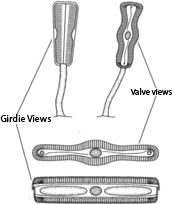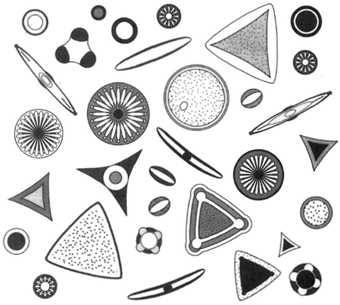Chrysophyta
The Chrysophyta are characterized as unicellular and have the pigments chlorophyll a, sometimes chlorophyll c, and perhaps chlorophyll e, carotenes, diadinoxanthin, and fucoxanthin. The products of photosynthesis are oils and the polysaccharide leucosin. Cell walls, if present, may have silica, calcium, and some organic material, but little or no cellulose.A student of algae soon comes to appreciate the uncertainties researchers face in attempting to classify these organisms. Some algae are relegated to the kingdom Monera, some to the kingdom Protista, and most to the kingdom Plantae. When it comes to Chrysophyta, the different points of view regarding classification are particularly striking. One point of view purports there to be three classes of Chrysophyta, another, two. In this text, two classes are considered: Chrysophyceae (the yellow-brown or golden algae) and Bacillariophyceae (diatoms).
 |
| Figure 16-5 (a) Dinobryon and (b) Distephanus |
Chrysophyceae
There are both amoeboid and flagellated types of Chrysophyceae. The flagella are two in number and unequal; one is pinnate, the other whiplash. The amoeboid forms are quite like the amoebas studied in zoology except that they have chloroplasts. Sexual reproduction is rare and isogamous. Approximately 300 species of Chrysophyceae have been described. Figure 16-5 shows two forms: Dinobryon and Distephanrts.
Bacillariophyceae (Diatoms)
Bacillariophyceae is a much larger class than Chrysophyceae, with 5,500 to (if fossil forms are included) nearly 10,000 species. Modern forms are found in both fresh water and sea water. The cell wall is composed of two parts; one part overlays the other in a manner similar to the parts of a pill box or petri dish. These are called frustules, the larger outer half being the epitheca, and the smaller inner half being the hypotheca. Each frustule is composed of two parts: a valve and a band. The bandso verlap, forming a girdle. The walls have a pectic substance richly impregnated with silica, which creates handsome patterns of minute perforations and striations. The silica account for as much as 90 percent of the cell wall. The pigments in the cell are chlorophyll a, chlorophyll c, carotenoids, and xanthophylls. Fucoxanthin is the most abundant pigment.
 |
| Figure 16-6 Pinnularia, a diatom |
The class is divided into two orders: the Centrales, which are radially symmetrical, and the Pennales, which are bilaterally symmetrical. The Pennales have no flagella, but they can glide along forwards and backwards by a halting kind of movement (which has yet to be explained). A fine groove called the raphe runs along the length of the frustule. A spherical nodule is in the center and a polar nodule is at either end of the raphe. The raphe and nodules may somehow contribute to the ability to move. Each cell has a single nucleus at the periphery of the cytoplasm and numbers of band-shaped or star-shaped chloroplasts. The products of photosynthesis are oil and a complex carbohydrate called chrysolaminarin.
When the cells divide, the frustules separate. Each frustule of the parent cell then functions as the epitheca of the new cell, a new hypotheca being formed within it. One can readily surmise that if a hypotheca functions as an epitheca in each succeeding generation, a gradual diminishing of cell size will result. This does, in fact, happen until a certain minimal size occurs; then, a sexual process of reproduction takes place, thereby restoring the original cell size.
In sexual reproduction, pennate diatoms produce amoeboid male gametes, which move through a mucilaginous matrix Both male and female gametes move toward each other. Diatoms are diploid (the first algae known to be so), and the gametes are the only haploid cells. This is similar to animal reproduction and uncommon in algae.
In the Centrales order of diatoms, the male gametes are flagellated (having a single pinnate flagellum) and are thus able to swim to the egg cells.
In ancient times, diatom skeletons settled to the bottom of the sea in enormous numbers, creating deposits many meters thick. In later geological times, these deposits lifted out of the ocean and formed mountainous deposits of diatomaceous earth. The city of Richmond, Virginia is built on a layer of diatoms fifty feet deep. Perhaps the most famous deposit of diatoms is found in Lompoc, California, where they lay 300 meters deep. Given that there are 40 million diatoms per cubic inch, this area certainly boasts an impressive number of diatoms!
Diatomaceous earth is used commercially in scouring powder, toothpaste, silver polish, sugar refining, filtering systems, and the manufacture of reflective paint. Because certain pollutants greatly increase their numbers while others have the reverse effect, populations of living diatoms are sometimes analyzed to obtain clues regarding ecological conditions.
 |
| Figure 16-7 Diatom reproduction. Each daughter cell receives one of the valves of the parent cell, the older valve always forming the epitheca (top lid) of the new individual. When the epitheca forms the top lid, the new form remains the same size. When the hypotheca forms the top lid, size diminishes. A continued reductionin size brings about sexual reproduction, which returns the cells to original size. |
 |
| Figure 16-8 Each species of diatom has a characteristic pattern. |




